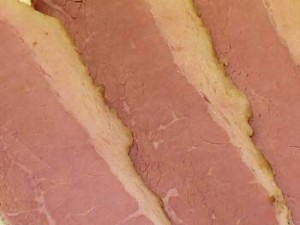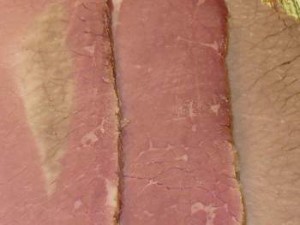Does Corned Beef Cure the Meat

Brining, also known as corning or sweet pickling is a adept meat curing method for beginners because it is easy and relatively inexpensive to practice with delicious results. To make corned beef, you immerse meat in alkali, which is only a solution of salt and water. Besides salt and water, at that place are a few other ingredients commonly used in a brining recipe for corned beefiness brisket.
- Salt preserves the meat, enhances flavor and helps carry sugar and spices throughout the food.
- Water is the other primal ingredient in alkali. Use distilled or filtered water if possible. If you utilize tap water, permit information technology represent 24 hours to misemploy the chlorine, which tin can interfere with the curing process. Hard h2o, water softeners, and fluoride also inhibit preservation activity.
- Nitrite turns meat a cherry-red-pink color and contributes unique flavor.
- Saccharide contributes sweetness and counteracts saltiness. You can employ whatsoever type of sugar, including granulated, brown, or dextrose. Dextrose is a refined corn sugar that dissolves readily.
- Spices add together flavor.
Where's the Corn in Corned Beef?
Corning is an old English language term that refers to pellets of common salt, called "corns". Therefore, corned beef is only meat preserved with common salt. It has null to exercise with the vegetable we all know (and love) as corn on the cob.
Best Common salt to use for Brining or Curing Meat
Many brining recipes exercise non specify the type of salt. However, pickling or canning salt is your best choice in brining recipes considering it is pure, fine-grained, and dissolves hands. Pickling and canning salt is bachelor in almost major grocery stores and often where canning supplies are sold. You lot can likewise society information technology on this website here. Kosher common salt is an acceptable substitute, simply fibroid grains take longer to dissolve than fine grains. Then get fine grain if you accept a choice.
Not recommended: table salt and sea table salt, because they contain additives or minerals that may inhibit the curing process.
Brining is more Art than Scientific discipline
There is no universal brining recipe for curing meat. Weak brine increases the curing time and stiff alkali decreases the curing time. It is generally recommended to apply weak brine for poultry, fish, and game birds, and strong alkali for beefiness, pork, and game meat.
Brine force is expressed equally a per centum of salt in proportion to the weight of the brine. Therefore, when yous brand brine, you measure out the salt in relation to the amount of water in the recipe.
Alkali Formulas: Weight or Book of Salt per Quart of H2o
| Alkali Strength (% Table salt) | Any Salt | MTPC* | MCK** | DK*** |
| five.vii% (weak) | 2.0 oz. | iii TB. | 1⁄4 loving cup | 6 TB. |
| 7.five% (weak) | 2.vii oz. | 1⁄four loving cup + 1 tsp. | ane⁄3 cup + i tsp. | 1⁄2 cup + 2 tsp. |
| 15.3% (stiff) | 6.0 oz. | 1⁄2 cup + i½ TB. | 3⁄4 cup + 1½ tsp. | 1 cup + three TB. |
*Morton Table, Pickling, or Canning (MTPC) salt weighs x ounces per loving cup
**Morton Coarse Kosher (MCK) salt weighs 7.7 ounces per cup
***Diamond Kosher (DK) salt weighs 5 ounces per cup
Skillful brine recipes volition requite yous the formula using the weight of the table salt. If dry measures are given, they can exist inaccurate unless they also specify the type and brand of salt. Measured by weight, five ounces of any blazon of salt is equivalent to any other kind. Measured by volume, ane type of table salt may require twice as much, as the table higher up shows (DK requires twice equally much by volume than MTCP.)
Determining how long to brine meat

Under-cured, evenly cured, and uncured beef brisket (photo by Carole Cancler)
Determining how long to brine meat depends on the brine forcefulness, the size and shape of the piece, and the texture of the meat. For weak brine, estimate three-4 days per pound. For strong brine, start with 2 days per pound. If curing time is also short, you will come across uneven color, especially at the center of the meat or under heavy layers of fat. If curing time is as well long by a few days, yous should not find whatsoever difference.
Note that brining a turkey for Thanksgiving dinner (or whatever other meat) for a day or two merely adds season. For preserving, the salt and other ingredients must fully readapt the water (the preservative activity) throughout the meat tissue, so timing needs to be much longer.
Curing Salts (Sodium Nitrate and Sodium Nitrite)
Saltpeter (sodium nitrate) is a naturally occurring mineral that has been used to cure meat for at to the lowest degree 1,000 years. Nitrate preserves meat by prohibiting the growth of spoilage leaner (especially C. botulinum) and preventing fats from going rancid.
Equally information technology turns out, nitrate isn't the active agent in meat curing, rather its derivative, nitrite. Nitrite causes the preservative furnishings, as well as the appetizing reddish-pink color and pleasing flavour that we acquaintance with cured meat. People continued to use nitrates only until nitrites became readily available. Nitrate is still used today only when a slow-cure method is needed for raw-cured products, such every bit dry pepperoni, dry salami, sopressata, and dry coppa.
Curing salt #1 or pinkish curing salt is a "fast" cure that contains sodium nitrite. It is known by various brand names, including InstaCure No. 1 (formerly Prague Pulverisation #one), DQ Curing Salt, and tinted curing mix (TCM). The pinkish colour ensures that users will not confuse it with whatever other blazon of salt. Apply cure #1 only in products that y'all volition melt before eating, such as corned beef and bacon. Never substitute pink curing common salt for any other type of table salt.
Tender Quick is a brand of fast curing salt made past Morton that can exist used to brand corned beef. Follow the bundle directions; Tender Quick is not interchangeable with curing salt #ane.
Curing salt #2 is a "dull" cure that contains sodium nitrate in addition to sodium nitrite. Information technology may or may not be pink colored. Cure #2 is used simply for making raw-cured products that are dry-anile for long periods and will not be smoked, canned, cooked, or refrigerated. Cure #ii is not interchangeable with curing table salt #1. Never apply cure #two in brine or substitute it for any other type of salt.
You can purchase curing salts online through retailers such as butcher-packer.com, mortonsalt.com, and sausagemaker.com.
Because corned beef is cooked after curing, sodium nitrite is not needed to control botulism. However, information technology does impart the characteristic pink color and flavor. If a pinkish color is all that is desired, as a little as 40 parts per millions (ppm) or 1 level teaspoon (0.xx ounce) per quart of water achieves the desired result. For preservative constructive, more than curing salt tin exist used, up to 200 ppm (one ounce or 5 level teaspoons per quart of water), the maximum amount recommended by the USDA for prophylactic consumption. Sodium nitrite is toxic in large amounts; under no circumstances should you apply more than 1 ounce of curing salt #ane per quart of water when making a brining solution.
If you lot don't take or don't want to utilize curing salt containing sodium nitrite, you can brine meats without information technology. Without curing salt that contains sodium nitrite, the color of the cured meat will be grayness rather than pink and the flavor is less sugariness with a more pronounced "pickle" flavor. Information technology turns out more like seasoned roast meat, than a cured meat.
Beefiness and Game Meat to employ for Corning
The most common cut used for corned beef is the brisket or circular. Game including antelope, acquit, elk, moose, and venison are as well first-class meats to preserve past the corned beef brining method. In game meat, brining removes the musky season and tenderizes even the toughest meat. As when making corned beef, brisket (lower chest) and round (leg) are proficient cuts of game meat to apply, as well as loin, rump, and shoulder. Pork is commonly cured by brining, including loin, rump, and shoulder for hams and belly for bacon. Lamb and veal practise not result in products with adept colour or flavor, then are not recommended for brining.
Tips for Brining Meats
- Use noncorrosive containers and weights such equally plastic, glass, stainless, or pickling crocks.
- Prepare enough alkali to cover meat completely.
- Estimate i quart of brine for every 4-6 pounds of meat (or xxx%-50% brine weight per pound of meat; 1 quart of alkali weighs ii pounds).
- To dissolve salt and sugar more than readily, heat half of the quantity of water and dissolve the table salt and the sugar completely before adding the remaining liquid.
- E'er chill brine thoroughly earlier adding the meat.
- Always cure meat in the refrigerator (<40°F).
- Turn or flip over brining meat in one case or twice daily. Rotation helps meat to cure evenly.
Making corned beef brisket is a good meat curing project for beginners that is easy to do. Corning uses stiff brine of salt and water with added sugar and spices for flavour. A pocket-sized amount of pinkish curing table salt containing sodium nitrite also adds characteristic colour and flavor.
For more details on the curing food preservation methods with recipes, see the book The Home Preserving Bible by Carole Cancler, or visit our online Amazon store for more books and equipment useful for curing meat and game products.
Source: http://www.homepreservingbible.com/1160-all-about-brining-and-curing-corned-beef-and-game-meat/
0 Response to "Does Corned Beef Cure the Meat"
ارسال یک نظر